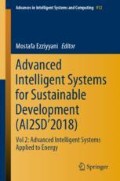Abstract
The increasing demand for water and the depleting fossil fuels for its treatment made renewable energies a better alternative source for feeding water desalination units. Photovoltaic (PV) energy is an important source of renewable energy that could be an alternative to satisfy the broad energy needs in the future.
Our project consists in the realization of a desalination mobile unit of brackish water based on solar energy which will serve as prototype for scientific research to develop many research axes. This prototype consists of different parts such as: The production of electrical energy by photovoltaic panels, DC/DC conversion, DC/AC conversion and water treatment.
PV system produces maximum output power in only one point on Power-Voltage (P-V) curve called Maximum Power Point (MPP). When the weather conditions change (such as temperature and irradiation), the voltage and current in the circuit change. In this case, a new MPP must be found based on Maximum Power Point Tracking algorithms (MPPT) to optimize the power generated by PV. Hence, many methods have been developed to determine MPP.
In this work, a comparison between two MPPT algorithms namely Perturb and Observe (P&O) and Incremental Conductance (InC) is presented. The simulations are accomplished by using a DC/DC Buck converter, a PV array and a load under MATLAB/Simulink environment. The obtained results, in different climatic conditions, reveal that the InC controller is more effective than P&O controller.
Access this chapter
Tax calculation will be finalised at checkout
Purchases are for personal use only
References
Garg, M.C., Joshi, H.: A review on PV-RO process: solution to drinking water scarcity due to high salinity in non-electrified rural areas. Sep. Sci. Technol. 50(8), 1270–1283 (2015)
Miller, S., Shemer, H., Semiat, R.: Energy and environmental issues in desalination. Desalination 366, 2–8 (2015)
Bourouni, K., Ben M’Barek, T., Al Taee, A.: Design and optimization of desalination reverse osmosis plants driven by renewable energies using genetic algorithms. Renew. Energy 36(3), 936–950 (2011)
Chung, K., Yeo, I.-H., Lee, W., Oh, Y.K., Kim, D., Park, Y.-G.: Investigation into design parameters in seawater reverse osmosis (SWRO) and pressure retarded osmosis (PRO) hybrid desalination process: a semi-pilot scale study. Desalin. Water Treat. 57(51), 24636–24644 (2016)
Agashichev, S., Lootahb, K.N.: Influence of temperature and permeate recovery on energy consumption of a reverse osmosis system. Desalination 3, 253–266 (2003)
Choudhary, D., Saxena, A.R.: DC-DC buck-converter for MPPT of PV system. Int. J. Emerg. Technol. Adv. Eng. 4(7), 813–821 (2014)
Srinivas, P., Lakshmi, K.V., Ch, R.: Simulation of incremental conductance MPPT algorithm for PV systems using LabVIEW. IJIREEICE 4, 34–38 (2016)
Agrawal, J.H., Aware, M.V.: Photovoltaic simulator developed in LabVIEW for evalution of MPPT techniques. In: International Conference on Electrical, Electronics, and Optimization Techniques (ICEEOT), pp. 1142–1147 (2016)
Selmi, T., Belghouthi, R.: A novel widespread Matlab/Simulink based modeling of InGaN double hetero-junction p-i-n solar cell. Int. J. Energy Environ. Eng. 8(4), 273–281 (2017)
Desai, H.P., Maheshwari, R.: Synchronized pulsed dc-dc converter as maximum power position tracker with wide load and insolation variation for stand alone PV system. Appl. Solar Energy 47(4), 271–280 (2011)
Moharram, K.A., Abd-Elhady, M.S., Kandil, H.A., El-Sherif, H.: Enhancing the performance of photovoltaic panels by water cooling. Ain Shams Eng. J. 4(4), 869–877 (2013)
Karami, N., Moubayed, N., Outbib, R.: general review and classification of different MPPT Techniques. Renew. Sustain. Energy Rev. 68, 1–18 (2017)
Nath-Naidu, B.A.: Voltage based P&O algorithm for maximum power point tracking using labview. Innov. Syst. Des. Eng. 7(5), 12–16 (2016)
Yadav, A.P.K., Thirumaliah, S., Haritha, G., Scholar, P.G.: Comparison of MPPT algorithms for dc-dc converters based PV systems. Int. J. Adv. Res. Electr. Electron. Instrum. Eng. 1(1), 18–23 (2012)
Kermadi, M., Berkouk, E.M.: Artificial intelligence-based maximum power point tracking controllers for Photovoltaic systems: comparative study. Renew. Sustain. Energy Rev. 69(C), 369–386 (2017)
Babaa, S.E., Armstrong, M., Pickert, V.: Overview of maximum power point tracking control methods for PV systems. J. Power Energy Eng. 20, 59 (2014)
Na, W., Carley, T., Ketcham, L., Zimmer, B., Chen, P.: Simple DSP implementation of maximum power pointer tracking and inverter control for solar energy applications. J. Power Energy Eng. 04(09), 61 (2016)
Francis, W.K., Mathew, P.J.: MATLAB/Simulink PV module model of P&O and DC link CDC MPPT algorithms with lab view real time monitoring and control over P&O technique. Int. J. Adv. Res. Electr. Electron. Instrum. Energy 3(5), 92–101 (1970)
Kumar, R., Choudhary, A., Koundal, G., Yadav, A.S.A.: Modelling/simulation of MPPT techniques for photovoltaic systems using Matlab. Int. J. 7(4), 178–187 (2017)
Author information
Authors and Affiliations
Corresponding author
Editor information
Editors and Affiliations
Rights and permissions
Copyright information
© 2019 Springer Nature Switzerland AG
About this paper
Cite this paper
Meryem, B., Ahmed, N., Sanaa, H., Ahmed, F. (2019). Optimization of PV Panel Using P&O and Incremental Conductance Algorithms for Desalination Mobile Unit. In: Ezziyyani, M. (eds) Advanced Intelligent Systems for Sustainable Development (AI2SD’2018). AI2SD 2018. Advances in Intelligent Systems and Computing, vol 912. Springer, Cham. https://doi.org/10.1007/978-3-030-12065-8_17
Download citation
DOI: https://doi.org/10.1007/978-3-030-12065-8_17
Published:
Publisher Name: Springer, Cham
Print ISBN: 978-3-030-12064-1
Online ISBN: 978-3-030-12065-8
eBook Packages: Intelligent Technologies and RoboticsIntelligent Technologies and Robotics (R0)

